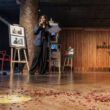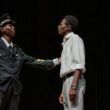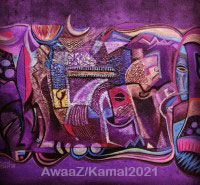‘I’m beginning to see …how naturally and inevitably I have become an artist.’
Kamal Shah, October 1999
Best known for being a painter, printmaker, textile designer, and award-winning mixed media (including digital) artist, Kamal Shah made the above modest observation more than 20 years ago in Mumbai, India, during the opening of his first solo exhibition at the acclaimed Jehangir Art Gallery. In subsequent years further solo exhibitions were held in Kenya, UK, Denmark and India. He also participated in art exhibitions in Spain, Japan, France and Germany.
One of the several awards he has won is the first prize [for mixed media] in 2006 at Kenya’s first juried Contemporary Kenyan Art Exhibition, organized by Kenya’s Ministry of Culture together with the Goethe Institute and Alliance Francaise. He has created artworks on commission for Sagana State Lodge, Kenya Airways, clients in Dubai and several leading banks.
But at birth, the so-called inevitability of Kamal becoming an artist was by no means apparent. The first-born son of a wholesale trader and a housewife was more likely to follow in his father’s footsteps and go into business or accountancy like most respectful sons did in the South Asian community.
For his education, however, Kamal’s parents gave him the opportunity to attend a new kind of school in Kenya, one that stressed diversity and the integration of all kinds of Kenyans into one multicultural system that had a vision for Kenya’s bright new independent future. Hospital Hill School (Primary) was Nairobi’s first mixed race school. It was established by John Karmali (South Asian) and his wife, Joan (English), who had envisioned a cosmopolitan education for their mixed-race children. They were supported in this venture by an African, Tom Mboya, and European, Sir Derek Erskine, who also sought to bridge the cultural gaps in the society; and in the process break down outmoded cultural practices like tribalism, racism and xenophobia.
In all those regards, Hospital Hill School worked well for Kamal. ‘I consider myself a citizen of the world,’ says the man who’s been bridging three continents for a good part of his life, first as a student, then as a globe-trotting nomad, and finally, as the quietly self-assured artist with intimate ties to Africa, India, and Europe.
Kamal describes himself as a ‘self-taught’ artist since he never attended an Art College. Instead, he studied English Literature, History of Fine Art, and Textile Design at the University of Leeds (UK). In fact, he studied art at Nairobi School (formerly the Prince of Wales) up to Form Four level.
But even before starting his formal schooling, Kamal had been introduced to art. In his extended family were two aunts who were students at the Highridge Teachers Training School. ‘Art and crafts’ was one of the subjects they studied. As a seven-year-old, Kamal was delighted whenever they brought home their art projects because he’d be shown how to do everything from painting and sculpting to knitting and weaving. He’d play with paints, rafia, clay, wood, pencils and paper, all of which made an indelible impression on the young boy who fell in love with fine art.
In fact, there were many other influences that shaped Kamal’s creative spirit. One was growing up in a house filled with music, especially classical Indian music which his father adored. The Orient Art Circle in Nairobi used to bring over well-known musicians from India to perform at the National Theatre. “My father would often invite them to our home where they would perform right there in our living room,” Kamal recalls.
In Nairobi school, he took art as a subject. Keith Harrington, an English artist, was his teacher for six years. During this time, Kamal produced paintings that he occasionally sold at City Market through the help of his father’s friend, George Nthenge. Nthenge’s shop manager was Ancent Soi, the famous Kenyan artist, who was also ‘exhibiting’ and selling his art at Stall #1. At that time Kamal created touristy art: wildlife, mother and child, masks, landscapes, etc.
With all those early indicators that Kamal was destined to be an artist, (not a shopkeeper), he continued to nurture that artistic spark in his heart. Upon his return from Leeds university, he was called to help manage the new family business. ‘Rowland Ward’ was a British colonial shop set in the heart of Nairobi’s CBD specializing in engraved crystal ware. When the family acquired it, Kamal expanded the specialty shop into a part-time art gallery for African arts and crafts.
A decade later, many of his family members decided to emigrate to Canada. Rather than continue with the Rowland Ward enterprise, Kamal decided to start up his own Africana-styled specialty shop with his business partner, Esther Ndisi in 1982. As artistic director at ‘Kichaka’, he would gradually get closer to his goal of making his passion for art his first priority; but that wouldn’t happen until he closed Kichaka in 1991.
Kamal wanted to concentrate solely on his artwork without having to attend to administrative and commercial concerns. Now he could travel. He embarked on what would become the most productive golden years of his artistic life. It was a time when he finally admitted to himself that he had always wanted to be an artist. And now was the time to do it. The nineties was the decade that Kamal began spending time in India. His first trip there was as a teen on a tour with his family. Kamal, being second generation Kenyan, had few family ties to the sub-continent. But he found the art scene in Goa especially vibrant and cosmopolitan. “It was also quite reasonable living so I would go and stay two or three months at a time,” he recalls.
Setting up a temporary studio wherever he stayed, he would paint all day, and attend art shows at night.
“Eventually, I started having exhibitions at several galleries in Mumbai and Goa. I exhibited in Mumbai’s prestigious Jehangir Art Gallery and the Taj Hotel’s renowned Art Gallery, and The Art Chamber in Goa.
Whenever Kamal came back home to Kenya, he would take part in a range of solo and group exhibitions in Nairobi, either at Alliance Francaise, the National Museum, RaMaMo, Gallery Watatu or UNEP.
Slipping into the 21st century saw Kamal’s artistic energies only ramp up as his artwork diversified incorporating influences from East and West but always centred in Kenya.
As has been the case with us all, including artists, exhibitions and sales have slowed down significantly since the arrival of COVID-19 and the ensuing lock-downs. Kamal has used the available time to vamp up his online artistry. As for now, his IPad Pro and digital styllus constitute his digitalized art materials.
“I try to keep up with this digital genre as best I can,” says Kamal as he doodles while he talks. He also illustrates how easily one can create digital art if they have the heart and mind for it. Currently creating a series of digital artworks, Kamal is waiting for the time when he can make them available on a cyrpto platform.
“Right now, no one is sure how to value works of digital art,” he says. But he is prepared to be patient, to wait and see. Otherwise, he continues to experiment with various painting apps and the colour, line, brush, texture, design, and perspective that are accessible on his iPad.
Kamal has always seen his education as the key that opened his mind to creating art that has ranged from the abstract to the figurative and on to a mix of fantasy, mythology, and esoteric mysticism.
“I like leaving a little that’s enigmatic in my art,” says Kamal with a twinkle in his eye. He clearly enjoys the idea of his art being slightly esoteric and elusive.
“Otherwise,” Kamal explains, “there is nothing terribly complicated about who I am. I am an artist and that is who I am”.










